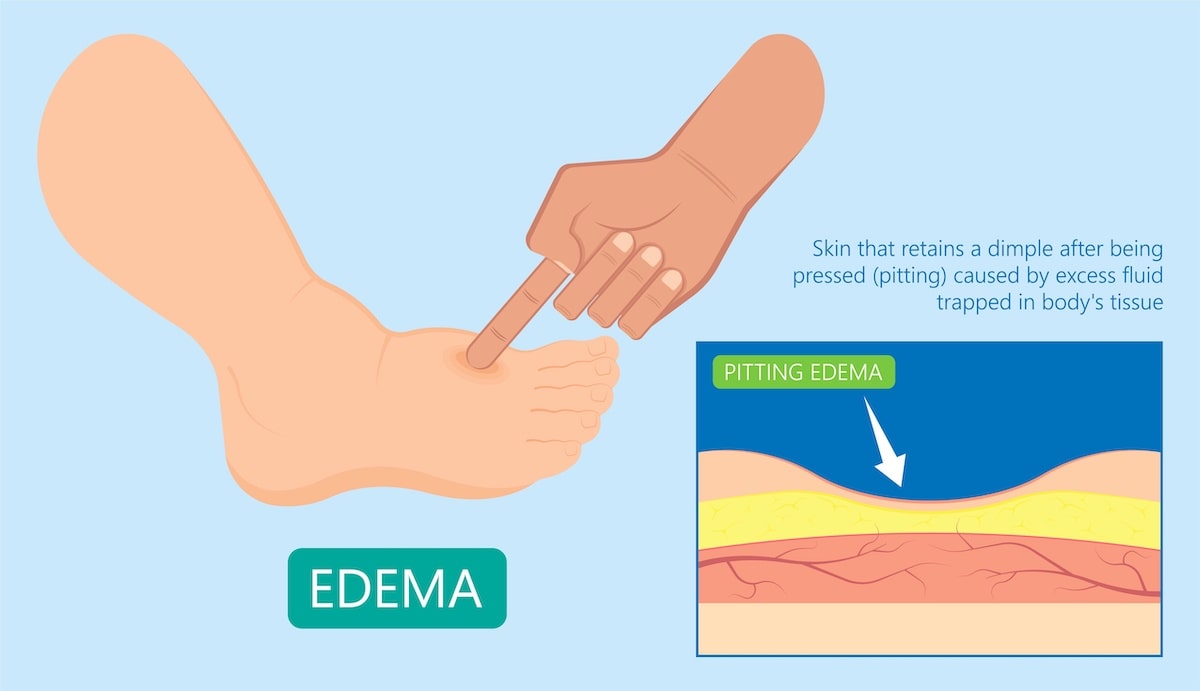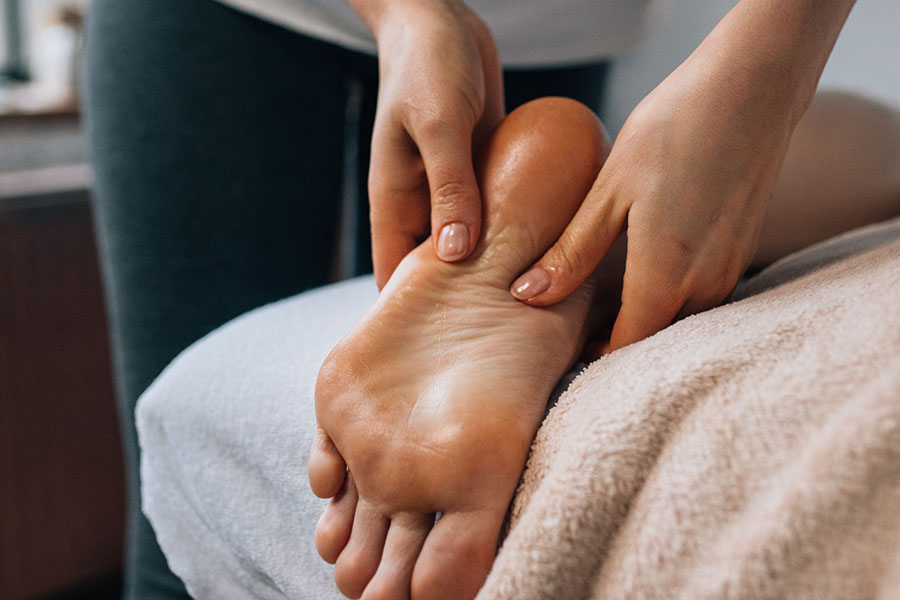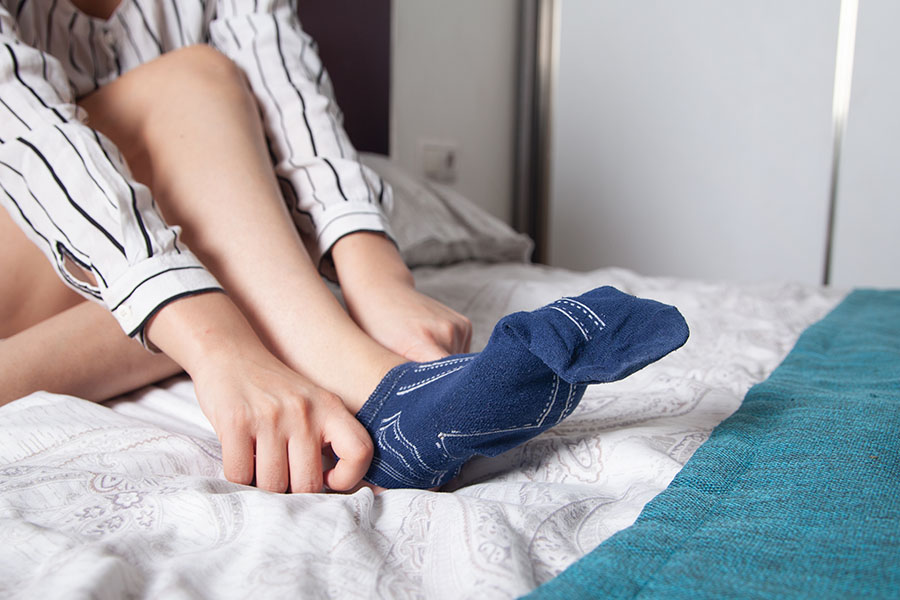How to Treat Diabetes Swollen Feet, Ankles, and Legs?

Diabetes swollen feet are a common foot problem among people living with diabetes. There’s a clear relationship between diabetes and peripheral edema – swelling in the feet, ankles, or legs. Swelling is often a sign of two diabetes complications affecting the lower limbs: peripheral artery disease and diabetic neuropathy.
Keeping your blood sugar levels in range and following a healthy lifestyle with an excellent diabetic foot care routine noticeably help reduce diabetes swollen feet and the pain and discomfort they cause. A few tips, accessories, and home remedies such as foot soaks, leg elevation, foot massages, or diabetic shoes for swollen feet work great in most cases!
Table of Contents
What are diabetes swollen feet?
Peripheral edema
Foot and leg swelling is scientifically called peripheral edema. It happens when excess fluid builds up in the body tissues. Peripheral edema can affect the feet, ankles, legs, and arms. Numerous factors can cause our lower limbs to swell: kidney or liver dysfunction, heart problems, chemotherapy, hot weather, burns, hormonal changes, lymphedema, obesity, pregnancy, medication, lifestyle, etc., and … diabetes. Feet and leg swelling can also occur after eating salty foods, standing, or sitting in the same position for too long.
Symptoms of diabetes swollen feet

Relationship between diabetes and swollen feet
Peripheral artery disease and poor blood circulation
Diabetic neuropathy and slow healing process
How can people with diabetes prevent swollen feet?
Keep your HbA1c below 7%
Lose weight and exercise
Obesity is often directly linked to diabetes. Being overweight also considerably increases the risk of foot and leg swelling, as excess body mass decreases blood circulation. Staying fit and active drastically reduces the risk of diabetes, swollen feet, and other diabetes complications!
Ten tips to reduce diabetes swollen feet
Diabetes swollen feet can be harrowing and cause great difficulty walking or standing up. Fortunately, there are many things to try at home to help reduce swelling and discomfort. Here are ten tips to help reduce foot and leg swelling caused by diabetes:
Remember: swollen feet can be a sign of severe diabetes complications. Always ask for your doctor’s advice first, and don’t forget to get your yearly diabetic foot exam.
1. Elevate swollen legs above heart level
Use gravity to your advantage and elevate your swollen legs and feet above the level of your heart. This position helps the excess fluid accumulated in the lower limb circulate back towards the heart.
You can put a pillow below your legs in bed. Or lay on a mat on the floor and put your legs up the wall. If you’re sitting at your desk, try placing your feet on top of an ottoman.
Start with 20 minutes session 2 or 3 times a day, and increase if needed.

2. Avoid a sedentary lifestyle.
Movement is one of the most efficient ways to prevent your feet from swelling. Avoid a sedentary lifestyle. Don’t stay in the same position all day. Don’t sit on the couch or at the desk for hours without moving.
Whatever you’re doing, remember to stretch your legs and keep your feet moving as often as possible. Physical exercise 30 minutes a day is a great way to reduce swelling, improve blood flow, stay fit, and lower your blood glucose levels.

3. Reduce salt intake and processed foods
Too much salt in your diet can cause swelling too. The body retains extra sodium, increasing fluid and water retention.
The 2020-2025 Dietary Guidelines for Americans recommend that a healthy adult consume less than 2,300 mg of sodium daily. However, Americans eat, on average, 3,400 mg of sodium per day.
Most of the excess sodium we eat comes from processed foods containing excess sugars. When living with diabetes, whether or not you have swollen feet, stay away from processed foods and cook fresh foods as much as possible.

4. Wear therapeutic shoes to avoid swollen feet
Edema can make walking difficult, and most shoes don’t accommodate swollen feet.
Some orthopedic footwear companies have designed shoes specifically for people with diabetes with swollen feet. They come with extra-wide openings, pressure-free designs, heavy cushioning, and enhanced comfort.
Wearing shoes for swollen feet can considerably reduce pain and discomfort while improving blood circulation and reducing swelling.

Massage swollen feet, ankles, and legs
Massages have been proven to help increase blood circulation and reduce swelling by draining excessive fluid.
Try gently massaging your lower limbs for at least 30-60 minutes daily from the bottom of your feet toward the heart. You can massage with your hands, book massage therapy sessions, or use a foot massager for neuropathy and swollen feet at home.

Use compression socks for swollen feet
Compression socks and stockings are made to boost blood circulation from the lower limbs back to the heart. They can significantly help reduce foot, ankle, and leg swelling. However, if you have diabetes, and especially if you have been diagnosed with peripheral artery disease, you should ask for your doctor’s advice before wearing compression socks. In some cases, they could do more harm than good. Read more: should diabetics wear compression socks?

Stay hydrated to reduce swelling.
Drinking more water when your body is swelling because of the accumulation of excess fluid might sound counterintuitive, but it’s not. The more water your drink, the more liquid you expel with urines. In other words, the more water you drink, the less you retain. You should drink at least 8 to 10 glasses of water per day.
Note: Some causes of edema related to heart or liver problems may need a water restriction instead. Ask for your doctor’s advice before increasing your water intake.

Essential oils for swelling
Although not FDA-regulated, the therapeutic effects of essential oils have long been documented. Some essential oils are believed to help reduce chronic swelling considerably. Spruce, Neroli, Plai, Lemon, Hemp, Peppermint, Eucalyptus, and Chamomille are often combined in anti-swell aromatherapy blends. Essential oils can also be used to manage diabetic neuropathy and foot pain.
Soak your swollen feet in Epsom salts
Epsom salt foot soak is one of the easiest and cheapest home remedies for swollen feet you can try at home. Epsom salts contain high levels of magnesium and sulfates. When used in foot baths, they’re believed to help reduce pain, swelling, and inflammation, soothe the skin, and promote overall foot health. Add about half a cup of Epsom salts to a basin or foot spa filled with warm water. Soak your feet for 20-30 minutes and dry thoroughly. You can add oils and essential oils to your Epsom salt foot bath. Be sure to purchase Epsom salt with the USP label for human use.
Note: diabetes swollen feet can be a sign of peripheral artery disease or diabetic peripheral neuropathy. It would be best if you always asked for your doctor’s advice before soaking your feet or applying any lotion.
Swollen feet and magnesium deficiency
Water retention in the lower limbs and swelling can signify a magnesium deficiency. In that case, treatments, including magnesium-rich foods or magnesium supplements, usually work great. Men are recommended to have 400-420 milligrams of magnesium a day. For women, the recommendations are 310-320 milligrams a day. There’s a significant amount of magnesium in foods like nuts, legumes, spinach, beans, tuna, dark chocolate, and bananas. Choose mineral water that has a higher level of magnesium. If that’s not enough, ask for your doctor’s advice about magnesium supplements.
Note: If you live with diabetes, always ask for your doctor’s advice before changing your diet or taking any food supplements.